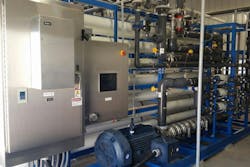Municipal desalination unit offers cost-effective solution
MIDLAND, Texas — Sept. 9, 2015 — STW Water, a wholly owned subsidiary of STW Resources Holding Corp., has designed, engineered and constructed the Horizon Municipal Utility District Reverse Osmosis (RO) Concentrator, according to a press release.
The firm is one of two eligible companies to design this type of concentrator, noted the release. The $2 million project was completed in the second quarter of 2015, but the contract allows STW Water to maintain the system.
The former RO plant was 13 years old, stated the release. Seven to nine million gallons of water were produced daily, and about one million gallons of brine water were discharged every day. Evaporation ponds collected the effluent, but more ponds were necessary because they did not evaporate quickly enough.
Land costs made this option economically unfeasible, so STW and its engineering partner, TRE & Associates, designed a concentrator to remedy the evaporation pond issue while neutralizing environmental concerns. The new system uses approximately half of the discharged water, and reclaims the other half into the distribution system.
“These two RO trains are recovering 700 gallons per minute (gpm) of water previously wasted as non-recoverable water from the concentrated brine stream of the existing reverse osmosis facility in Horizon City," said STW Resources CEO Stanley Weiner in the release. "The system is running at 99 [percent] rejection rate and saving and providing the city up to an additional 1,000,000 gallons of fresh water per day.”
“This is the second concentrator project in the state of Texas that I designed to recover the maximum amount of fresh water from brackish water," shared STW Water President Alan Murphy in the release. "Completing this project continues to validate our technology and our project development expertise. We look forward to continue to work with Horizon City and other cities that we are currently in negotiations with throughout Texas and California.”
Click here to read the entire release.
